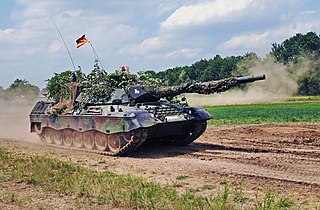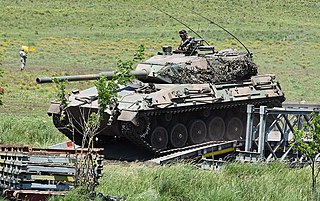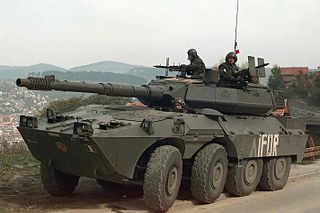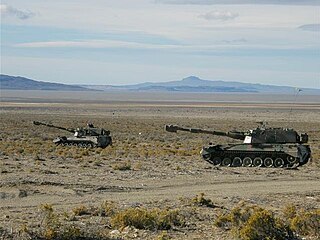
The Kampfpanzer Leopard 1 is a main battle tank designed by Porsche and manufactured by Krauss-Maffei in West Germany, first entering service in 1965. Developed in an era when HEAT warheads were thought to make conventional heavy armour of limited value, the Leopard design focused on effective firepower and mobility instead of heavy protection. It featured moderate armour, only effective against low caliber autocannons and heavy machine guns, giving it a high power-to-weight ratio. This, coupled with a modern suspension and drivetrain, gave the Leopard superior mobility and cross-country performance compared to most other main battle tanks of the era, only being rivaled by the French AMX-30 and Swedish Strv 103. The main armament of the Leopard consisted of a German license-built version of the British Royal Ordnance L7 105 mm rifled gun, one of the most effective and widespread tank guns of the era.

The T-35 was a Soviet multi-turreted heavy tank of the interwar period and early Second World War that saw limited service with the Red Army. Often called a land battleship, it was the only five-turreted heavy tank in the world to reach production, but proved to be slow and mechanically unreliable. Most of the T-35 tanks still operational at the time of Operation Barbarossa were lost due to mechanical failure rather than enemy action. It was designed to complement the contemporary T-28 medium tank; however, very few were built.

The Leclerc is a third-generation French main battle tank developed and manufactured by Nexter Systems. It was named in honour of Marshal Philippe Leclerc de Hauteclocque, a commander of the Free French Forces, who led the 2nd Armoured Division in World War II.

The Centurion was the primary British Army main battle tank of the post-World War II period. Introduced in 1945, it is widely considered to be one of the most successful post-war tank designs, remaining in production into the 1960s, and seeing combat into the 1980s. The chassis was adapted for several other roles, and these variants have remained in service. It was a very popular tank with good armour, mobility, and a powerful main armament.

The C1 Ariete is a 3rd generation main battle tank of the Italian Army, developed by Consorzio Iveco Oto Melara (CIO), a consortium formed by IVECO and OTO Melara. The chassis and engine were produced by Iveco, while the turret and fire-control system were supplied by OTO Melara. The vehicle carries the latest optical and digital-imaging and fire-control systems, enabling it to fight day and night and to fire on the move. Six prototypes were developed by 1988, which were subject to intensive testing. The following year the vehicles travelled a combined 16,000 km. Deliveries were first planned for 1993, and took place in 1994 due to delays. Final delivery occurred 7 years later in August 2002.

The FV4201 Chieftain was the main battle tank (MBT) of the United Kingdom from the 1960s into 1990s. When introduced, it was among the most heavily armed MBTs of the era, mounting a 120 mm Royal Ordnance L11 gun, the equal of the much larger specialist heavy tanks then in service. It also was among the most heavily armoured, with up to 195 mm (7.7 in) that was highly sloped to offer 388 mm (15.3 in) thickness along the line of sight.

The Tanque Argentino Mediano is a medium tank in service with the Argentine Army. Lacking the experience and resources to design a tank, the Argentine Ministry of Defense contracted German company Thyssen-Henschel. The vehicle was developed by a German and Argentine team of engineers, and was based on the German Marder infantry fighting vehicle chassis.

The Schützenpanzer Marder 1 is a tracked German infantry fighting vehicle designed for use with the West German Panzergrenadiere units, mechanized infantry specialized for IFV combat. It has been operated by the German Army as the main Panzergrenadiere IFV since the 1970s through to the present day. Developed as part of the rebuilding of West Germany's armoured fighting vehicle industry, the Marder has proven to be a successful and solid infantry fighting vehicle design.
OTO Melara was a subsidiary of the Italian company Finmeccanica, today Leonardo, active in the defence sector, with factories in Brescia and La Spezia. The Mod 56 pack howitzer, in service throughout the world, and the 76mm naval gun, adopted by 53 navies and installed on over 1,000 naval vessels, are among OTO Melara's best known weapons since World War II.

The Dardo is an infantry fighting vehicle designed for the Italian Army as a replacement for the M113 APC. It is designed and built by the Iveco Fiat Oto Melara Syndicated Company based in Rome. Iveco is responsible for the hull and propulsion systems, while Oto Melara is responsible for the weapons and fire control systems.

The Bionix (BX) is a family of tracked Singaporean armoured fighting vehicles developed by ST Kinetics. Intended to augment the Singapore Army's aging M113 armoured personnel carriers, it is the first indigenous armoured vehicle to be developed in Southeast Asia. The Bionix has been operational with the Singapore Armed Forces (SAF) since 1999 in a wide variety of adaptations including the Bionix II, Bionix 25 and Bionix 40/50 variants.

The Centauro is a family of Italian military vehicles originating from a wheeled tank destroyer for light to medium territorial defense and tactical reconnaissance. It was developed by a consortium of manufacturers, the Società Consortile Iveco Fiat - OTO Melara (CIO). Iveco Fiat was tasked with developing the hull and propulsion systems while Oto Melara was responsible for developing the turrets and weapon systems.

The Type 80 and the Type 88 are a family of Chinese second-generation main battle tanks (MBTs). They are also known as the ZTZ80 and ZTZ88.

The AMX-40 was a French main battle tank developed by GIAT during the latter stages of the Cold War as an export tank to replace the earlier AMX-32. Designed to be an inexpensive tank orientated towards militaries with smaller defence budgets, the AMX-40 featured a lightly armoured hull and good mobility reminiscent of previous French MBTs with a powerful 120 mm cannon. It however failed to attract interest and sales, rendering the project a failure, being discontinued in 1990.
BWP-2000 is a prototype Polish IFV developed from early 1990s to 1999 but eventually canceled.

The Palmaria is an Italian self-propelled howitzer using the 155 mm (6.1″) NATO-standard artillery calibre.

Tanks have been employed by the military forces in Italy since their first use in World War I. They have had continued use in wars after and are still used through the modern day. The C1 Ariete is the current main battle tank of the Italian Army.
The post–Cold War era is the period in world history from the collapse of the Soviet Union on December 27, 1991 to the present. During the Cold War, the Soviet domination of the Warsaw Pact led to effective standardization on a few tank designs. In comparison, France, Germany, the United States, and the United Kingdom had previously developed their own tank designs, but now tried to standardize their designs, while the smaller nations of NATO purchased or adapted these designs.
The Vickers Main Battle Tank Mk. 4 later known as the Vickers Valiant was a main battle tank developed as a private venture by British company Vickers for export. Its development began in 1976 and ended in January 1984. Although the Valiant did not enter production, its development provided valuable experience in the production of an aluminium-hulled, Chobham-armoured tank in the 40 tonnes weight range. A further development of its turret was later used for the Vickers Mk. 7 MBT.
The Vickers Main Battle Tank Mark 7 was a main battle tank developed on the basis of a joint venture between Vickers Defence Systems in the United Kingdom and Krauss-Maffei of Germany. It combined the Leopard 2 chassis with the Universal Turret previously developed for the Vickers Valiant main battle tank. The Vickers Mk. 7 was a key milestone in the development of the Challenger 2 as many of the features developed and successfully demonstrated in the turret of the Vickers Mk. 7 were later incorporated into the Challenger 2.















